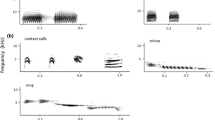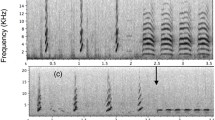Abstract
Alarm calls given by parents when risk is detected during nesting may be considered a form of parental defense. We analyzed variations in callings of breeding pairs of the Southern House Wren Troglodytes musculus during the nesting cycle and when faced with different predator models. Nesting birds were exposed to stuffed models at different nesting stages (early and late during incubation, and nests with younger and older nestlings). Nests were also exposed to different predator models where the calling response of breeding adults and acoustic structure variations of the calls were analyzed. The presence of a predator model increased the parents’ alarm calls along the nesting stage. This result supports the hypothesis that the higher the nest reproductive value, the higher the nest defense performed by the Southern House Wren. However, it also supports the notion that alarm calls could be used by parents to silence nestlings and reduce their detectability. Alarm calls also varied according to the predator model presented. We suggest that alarm calls variations of Southern House Wrens could encode information about the kind of predator and the risk envisaged through variations of call rates.




Similar content being viewed by others
References
Ackers SH, Slobodchikoff CN (1999) Communication of stimulus size and shape in alarm calls of Gunnison’s prairie dogs, Cynomys gunnisoni. Ethology 105:149–162
Andersson M, Wiklund G, Rundgren H (1980) Parental defence of offspring: a model and an example. Anim Behav 28:536–542
Belles-Isles JC, Picman J (1986) House wren nest-destroying behavior. Condor 88:190–193
Blumstein DT, Armitage KB (1997) Alarm calling in yellow-bellied marmots: I. The meaning of situationally-specific calls. Anim Behav 53:143–171
Burger J, Gochfeld M, Saliva JE, Gochfeld D, Gochfeld D, Morales H (1989) Antipredator behaviour in nesting zenaida doves (Zenaida aurita): parental investment or offspring vulnerability? Behaviour 65:129–143
Caro T (2005) Antipredator defences in birds and mammals. University of Chicago Press, Chicago
Charif RA, Mitchell S, Clark CW (1995) Canary 1.2 user’s manual. Cornell Laboratory of Ornithology, Ithaca
Corral MG (2007) Uso de claves auditivas en la evaluación del riesgo de depredación durante la cría de pichones en la ratona común, Troglodytes musculus. BSc Thesis, Universidad de Buenos Aires, Buenos Aires, Argentina
Curio E (1975) The functional organization of anti-predator behavior in the pied flycatcher: a study of avian visual perception. Anim Behav 23:1–115
Curio E (1987) Brood defence in the great tit: the influence of age, number and quality of young. Ardea 75:35–42
Davis NB, Madden JR, Butchart SHM (2004) Learning fine-tunes a specific response of nestlings to the parental alarm calls of their own species. Proc R Soc Lond B271:2297–2304
Delibes M, Travaini A, Zapata SC, Palomares F (2003) Alien mammals and the trophic position of the lesser grison (Galictis cuja) in Argentinean patagonia. Can J Zool 81:157–162
Dickinson EC (2003) The Howard & Moore complete check-list of the birds of the world, 3rd edn. Christopher Helm, London
Evans CS (1997) Referential signals. Perspect Ethol 12:99–143
Evans CS, Evans L, Marler P (1993a) On the meaning of alarm calls: functional reference in an avian vocal system. Anim Behav 46:23–38
Evans CS, Macedonia JM, Marler P (1993b) Effects of apparent size and speed on the response of chickens, Gallus gallus, to computer-generated simulations of aerial predators. Anim Behav 46:1–11
Fichtel C, Perry S, Gros-Louis J (2005) Alarm calls of white-faced capuchin monkeys: an acoustic analysis. Anim Behav 70:165–176
Ficken MS (1990) Acoustic characteristics of alarm calls associated with predation risk in chickadees. Anim Behav 39:400–401
Freed LA (1987) The Long-term pair bond of tropical house wrens: advantage or constrain? Am Nat 130:507–525
Gill SA, Sealy SG (2003) Test of two functions of alarm calls given by yellow warblers during nest defence. Can J Zool 81:1685–1690
Gill SA, Sealy SG (2004) Functional reference in an alarm signal given during nest defence: seet calls of yellow warblers denote brood-parasitic brown-headed cowbirds. Behav Ecol Sociobiol 56:71–80
Greig-Smith PW (1980) Parental investment in nest defence by stonechats (Saxicola torquata). Anim Behav 28:604–619
Haftorn S (1993) Ontogeny of the vocal repertoire in the willow tit Parus montanus. Ornis Scand 24:267–289
Hasson O (1991) Pursuit-deterrent signals: communication between prey and predator. Trends Ecol Evol 6:325–329
Högstad O (1995) Alarm calling by willow tits, Parus montanus, as mate investment. Anim Behav 49:221–225
Johnson AW (1965) The birds of Chile and adjacent regions of Argentina, Bolivia, and Peru. Platt Buenos Aires, Argentina
Kattan GH (1997) Shiny cowbirds follow the ‘shotgun’ strategy of brood parasitism. Anim Behav 53:647–654
Kattan GH (1998) Impact of brood parasitism: why do house wrens accept shiny cowbird eggs? In: Rothstein SI, Robinson SK (eds) Parasitic birds and their hosts. Oxford University Press, New York, pp 212–220
Kleindorfer S, Hoi H, Fessl B (1996) Alarm calls and chick reactions in the moustached warbler, Acrocephalus melanopogon. Anim Behav 51:1199–1206
Kleindorfer S, Fessl B, Hoi H (2005) Avian nest defence behaviour: assessment in relation to predator distance and type, and nest height. Anim Behav 69:307–313
Klump GM, Curio E (1983) Reactions of blue tits Parus caeruleus to hawk models of different sizes. Bird Behav 4:78–81
Klump GM, Kretzschmar E, Curio E (1986) The hearing of an avian predator and its avian prey. Behav Ecol Sociobiol 18:317–323
Laiolo P, Tella JL, Carrete M, Serrano D, López G (2004) Distress calls may honestly signal bird quality to predators. Proc R Soc Lond B271:S513–S515
Leavesley AJ, Magrath RD (2005) Communicating about danger: urgency alarm calling in a bird. Anim Behav 70:365–373
Macedonia JM, Evans CS (1993) Variation among mammalian alarm call systems and the problem of meaning in animal signals. Ethology 93:177–197
Magrath RD, Platzen D, Kondo J (2006) From nestling calls to fledgling silence: adaptive timing of change in response to aerial alarm calls. Proc R Soc B273:2335–2341
Manser MB (2001) The acoustic structure of suricates’ alarm calls varies with predator type and the level of response urgency. Proc R Soc Lond B268:2315–2324
Manser MB, Seyfarth RM, Cheney DL (2002) Suricate alarm calls signal predator class and urgency. Trends Cogn Sci 6:55–57
Marler P (1955) Characteristics of some animal calls. Nature 176:6–8
Marler P, Evans CS, Hauser MD (1992) Animals signals: motivational, referential, or both? In: Papousek H, Jürgens U, Papousek M (eds) Nonverbal vocal communication: comparative and developmental approaches. Cambridge University Press, Cambridge, pp 66–86
Marti CD (1996) Diet and trophic characteristics of great horned owls in Southwestern Idaho. J Field Ornithol 67:499–506
Mezquida ET, Marone L (2003) Are results of artificial nest experiments a valid indicator of success of natural nest? Wilson Bull 115:270–276
Montgomerie R, Weatherhead PJ (1988) Risks and rewards of nest defence by parent birds. Q Rev Biol 63:167–187
Morrison JL, Phillips LM (2000) Nesting habitat and success of the chimango caracara in Southern Chile. Wilson Bull 112:225–232
Palleroni A, Hauser M, Marler P (2005) Do responses of galliform birds vary adaptively with predator size? Anim Cogn 8:200–210
Platzen D, Magrath RD (2004) Parental alarm calls suppress nestling vocalization. Proc R Soc Lond B271:1271–1276
Platzen D, Magrath RD (2005) Adaptive differences in response to two types of parental alarm call in altricial nestlings. Proc R Soc Lond B272:1101–1106
Pribil S, Picman J (1991) Why house wrens destroy clutches of other birds: a support for the nest site competition hypothesis. Condor 93:184–185
Quinn MS, Holroyd GL (1989) Nestling and egg destruction by house wrens. Condor 91:206–207
Redondo T, Carranza J (1989) Offspring reproductive value and nest defense in the magpie (Pica pica). Behav Ecol Sociobiol 25:369–378
Serra C (2008) Sentido funcional de los llamados de alarma durante la cría de pichones en la Ratona Común, Troglodytes aedon. BSc Thesis, Universidad de Buenos Aires, Buenos Aires, Argentina
Skutch AF (1953) Life history of the southern house wren. Condor 55:121–149
Tabachnick BG, Fidell LS (1996) Using multivariate statistics, 3rd edn. Harper Collins Publishers, New York
Templeton CN, Greene E, Davis K (2005) Allometry of alarm calls: Black-capped chickadees encode information about predator size. Science 308:1934–1937
Tuero DT, Fiorini VD, Reboreda JC (2007) Effects of shiny cowbirds Molothrus bonariensis parasitism on different components of house wren Troglodytes aedon reproductive success. Ibis 149:521–529
Veen T, Richardson DS, Blaakmeer K, Komdeur J (2000) Experimental evidence for innate predator recognition in the Seychelles warbler. Proc R Soc Lond B267:2253–2258
Vuillermoz PA (2001) Dieta estacional y selección de presas del gato montés (Oncifelis geoffroyi) y zorro pampeano (Pseudalopex gymnocercus) en la Reserva de Vida Silvestre “Campos del Tuyú” (Bahía de Samborombón). BSc Thesis, Universidad de Buenos Aires
Warkentin DJ, Keeley ATH, Hare JF (2001) Repetitive calls of juvenile Richardson’s ground squirrels (Spermophilus richardsonii) communicates response urgency. Can J Zool 79:569–573
Weatherhead PJ (1979) Do savannah sparrows commit the concorde fallacy? Behav Ecol Sociobiol 5:373–381
Wood SR, Sanderson KJ, Evans CS (2000) Perception of terrestrial and aerial alarm calls by honeyeaters and falcons. Aust J Zool 48:127–134
Woodman N, Dove CJ, Peurach SC (2005) A curious pellet from a great horned owl (Bubo virginianus). Northeast Nat 12:127–132
Yensen E, Tarifa T (2003) Galictis cuja. Mammal Species 728:1–3
Young BE (1994) Geographic and seasonal patterns of clutch-size variation in house wrens. Auk 111:545–555
Zar JH (1996) Biostatistic analysis. Prentice-Hall, Upper Saddle River
Acknowledgments
We thank Luis García and the owner of “La Esperanza” (General Lavalle) for allowing us to perform this study at their ranch. M. Beade from Fundación Vida Silvestre Argentina provided logistical support during fieldwork. We thank M.G. Corral, N.M. Duré Ruiz, C. Haupt, P. Llambías, M.E. Mermoz and C. Serra for their collaboration in the field and C. Penedo, M. Carro, J. Crespo and two anonymous reviewers for corrections and suggestions to an earlier version of this paper. F.M. Gabelli lent us the audio-recording equipment. This study was supported by grants to G.J.F. from Universidad de Buenos Aires (UBACYT, Programación 2004–2007, UBACYT-X007) and Neotropical Grassland Conservancy (Equipment Grant, 2003). All methods used in the present study meet the ethical requirements for science research of the University of Buenos Aires and comply with the current laws of our country.
Author information
Authors and Affiliations
Corresponding author
Additional information
Communicated by P. H. Becker.
Rights and permissions
About this article
Cite this article
Fasanella, M., Fernández, G.J. Alarm calls of the Southern House Wren Troglodytes musculus: variation with nesting stage and predator model. J Ornithol 150, 853–863 (2009). https://doi.org/10.1007/s10336-009-0406-2
Received:
Revised:
Accepted:
Published:
Issue Date:
DOI: https://doi.org/10.1007/s10336-009-0406-2




